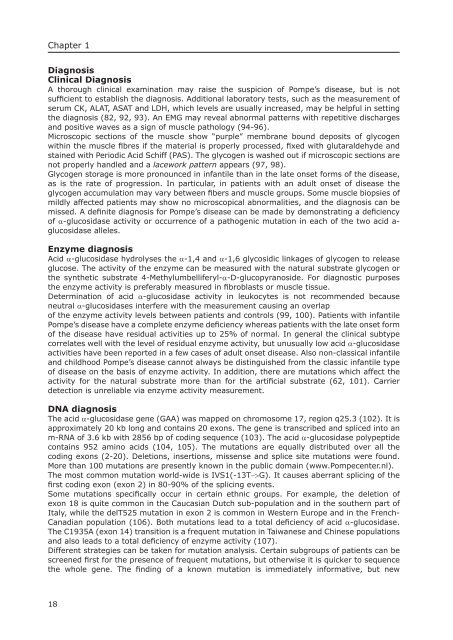Pompe's disease - RePub - Erasmus Universiteit Rotterdam
Pompe's disease - RePub - Erasmus Universiteit Rotterdam
Pompe's disease - RePub - Erasmus Universiteit Rotterdam
Create successful ePaper yourself
Turn your PDF publications into a flip-book with our unique Google optimized e-Paper software.
Chapter 1<br />
Diagnosis<br />
Clinical Diagnosis<br />
A thorough clinical examination may raise the suspicion of Pompe’s <strong>disease</strong>, but is not<br />
suffi cient to establish the diagnosis. Additional laboratory tests, such as the measurement of<br />
serum CK, ALAT, ASAT and LDH, which levels are usually increased, may be helpful in setting<br />
the diagnosis (82, 92, 93). An EMG may reveal abnormal patterns with repetitive discharges<br />
and positive waves as a sign of muscle pathology (94-96).<br />
Microscopic sections of the muscle show “purple” membrane bound deposits of glycogen<br />
within the muscle fi bres if the material is properly processed, fi xed with glutaraldehyde and<br />
stained with Periodic Acid Schiff (PAS). The glycogen is washed out if microscopic sections are<br />
not properly handled and a lacework pattern appears (97, 98).<br />
Glycogen storage is more pronounced in infantile than in the late onset forms of the <strong>disease</strong>,<br />
as is the rate of progression. In particular, in patients with an adult onset of <strong>disease</strong> the<br />
glycogen accumulation may vary between fi bers and muscle groups. Some muscle biopsies of<br />
mildly affected patients may show no microscopical abnormalities, and the diagnosis can be<br />
missed. A defi nite diagnosis for Pompe’s <strong>disease</strong> can be made by demonstrating a defi ciency<br />
of α-glucosidase activity or occurrence of a pathogenic mutation in each of the two acid aglucosidase<br />
alleles.<br />
Enzyme diagnosis<br />
Acid α-glucosidase hydrolyses the α-1,4 and α-1,6 glycosidic linkages of glycogen to release<br />
glucose. The activity of the enzyme can be measured with the natural substrate glycogen or<br />
the synthetic substrate 4-Methylumbelliferyl-α-D-glucopyranoside. For diagnostic purposes<br />
the enzyme activity is preferably measured in fi broblasts or muscle tissue.<br />
Determination of acid α-glucosidase activity in leukocytes is not recommended because<br />
neutral α-glucosidases interfere with the measurement causing an overlap<br />
of the enzyme activity levels between patients and controls (99, 100). Patients with infantile<br />
Pompe’s <strong>disease</strong> have a complete enzyme defi ciency whereas patients with the late onset form<br />
of the <strong>disease</strong> have residual activities up to 25% of normal. In general the clinical subtype<br />
correlates well with the level of residual enzyme activity, but unusually low acid α-glucosidase<br />
activities have been reported in a few cases of adult onset <strong>disease</strong>. Also non-classical infantile<br />
and childhood Pompe’s <strong>disease</strong> cannot always be distinguished from the classic infantile type<br />
of <strong>disease</strong> on the basis of enzyme activity. In addition, there are mutations which affect the<br />
activity for the natural substrate more than for the artifi cial substrate (62, 101). Carrier<br />
detection is unreliable via enzyme activity measurement.<br />
DNA diagnosis<br />
The acid α-glucosidase gene (GAA) was mapped on chromosome 17, region q25.3 (102). It is<br />
approximately 20 kb long and contains 20 exons. The gene is transcribed and spliced into an<br />
m-RNA of 3.6 kb with 2856 bp of coding sequence (103). The acid α-glucosidase polypeptide<br />
contains 952 amino acids (104, 105). The mutations are equally distributed over all the<br />
coding exons (2-20). Deletions, insertions, missense and splice site mutations were found.<br />
More than 100 mutations are presently known in the public domain (www.Pompecenter.nl).<br />
The most common mutation world-wide is IVS1(-13T−>G). It causes aberrant splicing of the<br />
fi rst coding exon (exon 2) in 80-90% of the splicing events.<br />
Some mutations specifi cally occur in certain ethnic groups. For example, the deletion of<br />
exon 18 is quite common in the Caucasian Dutch sub-population and in the southern part of<br />
Italy, while the delT525 mutation in exon 2 is common in Western Europe and in the French-<br />
Canadian population (106). Both mutations lead to a total defi ciency of acid α-glucosidase.<br />
The C1935A (exon 14) transition is a frequent mutation in Taiwanese and Chinese populations<br />
and also leads to a total defi ciency of enzyme activity (107).<br />
Different strategies can be taken for mutation analysis. Certain subgroups of patients can be<br />
screened fi rst for the presence of frequent mutations, but otherwise it is quicker to sequence<br />
the whole gene. The fi nding of a known mutation is immediately informative, but new<br />
18

















